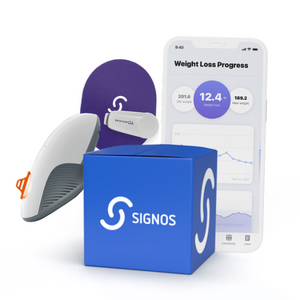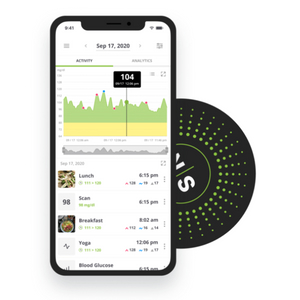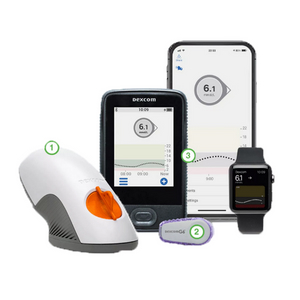 Expert's opinion
Expert's opinion
The article is a subjective view on this topic written by writers specializing in medical writing.
It may reflect on a personal journey surrounding struggles with an illness or medical condition, involve product comparisons, diet considerations, or other health-related opinions.
Although the view is entirely that of the writer, it is based on academic experiences and scientific research they have conducted; it is fact-checked by a team of degreed medical experts, and validated by sources attached to the article.
The numbers in parenthesis (1,2,3) will take you to clickable links to related scientific papers.
Signos Reviews 2024: Does This Device Work For Weight Loss?
All articles are produced independently. When you click our links for purchasing products, we earn an affiliate commission. Learn more about how we earn revenue by reading our advertise disclaimer.

7.0
Quality
10.0
Support Research
8.0
Reputation
7.0
Price
Features
- Individualized metabolic health technology.
- Real-time continuous glucose monitoring.
- Guides you on stabilizing blood sugar.
- It may help you lose weight.
- Encourages sustained weight loss.
- Logs food, sleep, hydration, and activity data.
- Featured in Forbes and Modern Healthcare.
- Encourages micro-changes for a healthier lifestyle.
Brand Information
- Headquarters located in Burlingame, California
- First CGM using artificial intelligence
Medical Benefits
- Weight loss management
- Continuous glucose monitoring
- Recommends changes for optimal health
About The Brand
If you feel like you’re constantly guessing which diet or exercise routine can help you reach health goals, like losing weight and keeping it off, there is a product on the market to take the guesswork out of the equation for you. The company Signos is on a mission to tackle the obesity epidemic, one personalized health assessment at a time.
What Is Signos?
Signos is more than just an app for weight loss. This app connects to one of the current top-selling continuous glucose monitors, also known as a CGM, to help people learn how their body responds to different foods and drinks so they can optimize their health.
Recognized by big businesses like Forbes and Modern Healthcare, the Signos app pairs with an FDA-regulated class III medical CGM device that Dexcom manufactures. It is Bluetooth-connected and water-resistant to help you monitor your blood glucose levels and make micro-changes to meet your health goals, including sleep, exercise, eating and drinking right, and losing weight.
Is this CGM capable of providing information to help you achieve sustainable weight loss and other healthy changes? Let’s look at Signos reviews, how it works, its costs, and potential side effects.
Feature Product & Coupon

Best Reputation
Signos
- Individualized metabolic health technology.
- Real-time continuous glucose monitoring.
- Guides you on stabilizing blood sugar.
- It may help you lose weight.
- Encourages sustained weight loss.
- Logs food, sleep, hydration, and activity data.
- Featured in Forbes and Modern Healthcare.
- Encourages micro-changes for a healthier lifestyle.
How Does It Work?
There are three parts to a CGM — the sensor that obtains the glucose information, the transmitter that takes the glucose information and sends it to a receiver, and the smartphone app or device that displays the information.
Signos is a wearable CGM that attaches to you by inserting a tiny microfilament[1] the size of a kitten’s whisker that sits in your skin. The website says it’s not uncomfortable and that you’ll barely notice it’s there.
Once the device is connected to you and enabled via a Bluetooth signal to the Signos app, it continuously tracks your glucose levels through your interstitial fluids (or the fluid between your cells) and reports your body’s glucose levels back to the app so it can give you suggestions to help you optimize your metabolism.
It has the potential to achieve positive results by giving you the data you need to make positive lifestyle changes and the recommendations you need to make those changes based on how your body reacts to your:
- Current eating and drinking habits.
- Stress levels.
- Sleep patterns.
- Exercise routine.
Taking action on the small changes they suggest may all add up and improve your health outlook by making it less challenging to maintain a healthy weight.
Following the guidance of the CGM may help reduce the chance of your glucose levels being too high or unstable, which can lead to gaining and hanging on to extra pounds and overall poor health.
Where Do I Begin?
After they accept you into the program and you start your journey as a Signos member, you’ll create a food, drink, and exercise log so they can learn how your glucose levels react to your lifestyle. They also give you a free digital telehealth assessment. Then, with the data, the CGM device sends on your glucose levels, plus your input, Signos can provide you with individualized nutrition suggestions.
How your body reacts to what you eat or drink provides timely data for real-time feedback on your blood sugar levels. Suggestions from Signos may include which foods are best for you, when you should eat, and when you should exercise to stabilize your glucose levels and reach your optimal weight loss range. It’s up to you to take action to implement the changes for better health.
What Is Glucose, And Why Would You Want To Monitor It?
Signos feels glucose could be the ideal biometric to track to achieve better health. When your body digests food, it turns it into glucose and uses it as energy. Glucose[2] is the main energy source that helps to fuel the body for activities of daily living.
Eating certain foods, like refined carbs or added sugar, or consuming too much food can cause a glucose spike, where blood sugar levels rise too high too quickly, leading to various unwanted health responses.
If you have excess glucose from eating or drinking high amounts of sugar, or if your body doesn’t get to use all of the glucose as fuel, as may happen with inactivity, then you have extra glucose in your body. This excess glucose is stored as fat and can cause fatigue, weight gain, trouble losing weight, and all the consequences of carrying excess weight.
Using the data that Signos tells you about your eating and drinking habits and making dietary and activity changes based on that data may allow you to achieve stable glucose levels, thus avoiding high and low blood sugar.
Does Science Support CGM Claims?
- Stabilizing glucose levels[3] can lead to weight loss.
- There has been a randomized controlled trial[4] regarding CGM use resulting in successful improvement of glucose management.
- On top of what science already shows a CGM can do, Signos is currently conducting a three-year study with 20,000 participants set to complete fall of 2026. This study aims to deliver the effectiveness of the Signos program in helping people lose weight, improve their body composition, and increase their overall health status.
Pros
- Weight management tool.
- Data and recommendations may benefit your overall health.
- Can sync data with your smartwatch or ring.
- Challenges with friends or community available.
- Glucose spike alerts and advice.
- Logs food, sleep, hydration, and activity data.
- Shows glucose range goals for weight loss.
- Individualized metabolic health technology.
- Provides educational insight and progress reports.
Cons
- Expensive.
- Only for non-diabetic users.
- Limited Signos reviews for weight loss are available.
- No device refunds available.
- Early cancellation fee.
Alternatives To Signos

Nutrisense
- Real-time glucose monitoring.
- Consult with a Registered Dietitian.
- Healthcare worker discount.
- Cannot share real-time data.
- Can only go three feet underwater.

Dexcom G6
- Real-time glucose monitoring.
- Available for diabetics.
- Can share your data.
- Covered by most insurances.
- Limited phone compatibility.
- Plastic auto-inserter to store.
Health Benefits Of Signos
Using a device that continuously monitors your glucose levels can be beneficial even if you don’t have diabetes.
Stabilizing your glucose levels can assist you with weight maintenance, muscle growth, and improving your energy levels, athletic performance, and immune function, lowering your risk of chronic disease. Here are a few of the benefits of using Signos.
Continuous Metabolic Tracking
Signos provides you with a device that can give you real-time tracking of your body’s response, increasing your metabolic knowledge so you can be proactive and successful in meeting your health goals. Ninety percent of CGM users report[5] an improvement in their overall health.
It may help you avoid overeating or eating out of boredom. For example, if you use the CGM and check your most recent glucose levels before eating, you may find your levels are high and that you should wait to eat and use the extra fuel your body has to stabilize your glucose before eating again.
Use the CGM as guidance to help you avoid unstable glucose levels that cause you to store excess fat.
Personalized Nutrition
Signos takes the data you and the CGM provide and informs you of your body’s specific needs so that you can actively participate in your own health. This kind of personalized nutritional advice[6] may be life-changing.
Build Lasting Habits
Signos CGM aims to help people intentionally create a healthier life by making possible changes in their routines. People who use a CGM may be more likely to stick to and improve their exercise routine with the app’s encouragement.
Furthermore, most CGM users modify their eating habits based on the glucose data. The Signos website tells us that almost half of CGM users are more likely to go for a walk or increase their physical activity after seeing a rise in their blood sugar.
The overall satisfaction[7] rate of CGM users using a low-carbohydrate diet is a resounding 93%.
Potential Side Effects
Let’s discuss the potential side effects that Signos mentions on its website. In rare cases of <1%, you may be allergic to the sensory adhesive, which is made with a hypoallergenic and latex-free medical grade acrylic sure polymer. They mention that if this happens to you, apply the patch first and then the sensor on top of it.
Pain or discomfort is uncommon, but Signos mentions if this occurs, place your next sensor in another part of your body and do not use the same location twice in a row. If you take the sensor off early, the company asks that you contact them and stay on track using another sensor or wait for the replacement.
How Much Does Signos Cost?
Signos CGM is not currently covered by health insurance. They have three different options for subscribing.
- One month of service: $399.
- Three months of service: $199/month (Total of $597).
- Six months of service: $159/month (Total of $954).
Each plan includes:
- The Signos device kit with the transmitter, sensors, waterproof performance covers, alcohol wipes, a glucose drink for the glucose calibration test, and an instruction booklet.
- Free shipping.
- Signos app access.
- Access to an in-app nutritionist.
- AI-powered weight loss insight and program.
- Digital telehealth assessment with a physician.
How To Use Signos
Once you go through the approval process for device and app access, you’ll receive the sensor and covers through the mail, and shipping usually takes one to three weeks. You’ll also receive a kit with instructions on correctly attaching the sensor.
You apply the cover like a bandaid. It’s small enough to be worn discreetly under your clothes on your upper arm or stomach. You’ll alternate locations when you change out the sensor.
To use Signos, you apply the CGM to your body as the kit instructions will tell you and protect the sensor with a flexible, durable, soft cover that’s soft on top. The cover will help protect it from water, movement, and sleep.
Then it reads and sends your biodata. This data will tell you how your body reacts to the different types of food, drink, and exercise routines that you log into the app.
To see any changes, you need to take action and adjust your eating habits to reduce glucose spikes as much as possible.
You’ll receive an alert from the Dexcom app when it’s time to change the sensor, which is usually around every 10 to 14 days.
Signos Review: What Do Real Users Say?
Signos only has a few reviews for public viewing on its website and external sources like Reddit. Let’s see what customers say.
I always thought that I couldn’t eat fruit because it spiked my blood sugar. But I’m finding that I can eat a variety of fruit and stay stable. I absolutely love the program.
Robbie T.
I’ve connected with my body in new ways. I am shocked by how much stress spikes me; I now have the incentive to make time for self-care.
Kristen M.
No diet has worked for me long term. The Signos program is different because it shows me how food, exercise, and hydration affect my body in real-time. This program is changing my life!”
Dolly N.
I have lost 15 lbs over the past two months. What I have found to be most helpful is that by controlling my glucose levels, I find that I have more consistent energy throughout the day.
Doug C.
My husband and I are both losing weight. I’m enjoying challenging my husband on time in the range—that is really motivating.
Megan S.
It’s been just over a month. I have learned so much. Not only have I lost 8 lbs, but overall I feel better. I know when to eat and what not to eat. I think this has been the best investment I have made in myself.
LC
Final Thought
Signos is a continuous glucose monitor that attaches to your skin to track what causes your glucose levels to rise and fall. It combines this with your input on your stress levels, food, drinks, exercise, and sleep patterns to give you personalized suggestions on small actions you can take with your lifestyle to improve your health.
When done correctly, the suggestions can help you to make lasting changes to your lifestyle that can benefit your weight management and overall health.
It combines a personal trainer, life coach, weight loss program, and nutritionist all in one. The cost of Signos CGM ranges from $159 to $399 for each month of service.
There are rare side effects of pain, discomfort, or allergic reaction to the sensor adhesive.
While CGMs were initially created for people with diabetes, Signos does not currently accept diabetic users. If you have diabetes and want to use a CGM, get a medical consult with a physician to see your best options.
Frequently Asked Questions
Yes, a continuous glucose monitor can assist you in getting the information you need to make positive changes to your eating and drinking habits that can result in weight loss.
There is no current evidence that Signos is one of the FDA-approved CGMs.
Depending on the manufacturer, a CGM can last for days to several months.
Signos currently only allows access to non-diabetics.
Not at this time.
Yes, this CGM is made to withstand depths of water up to 8 feet and 95% humidity. Hot tub temperature limits are 107.6 degrees Fahrenheit.
Since data continuously transmits from the device to the app, you do not need to scan the CGM. Your phone will need to have Bluetooth enabled and be within 20 feet of you to receive data updates.
iPhone 6s or newer and Android are compatible.
+ 7 sources
Health Canal avoids using tertiary references. We have strict sourcing guidelines and rely on peer-reviewed studies, academic researches from medical associations and institutions. To ensure the accuracy of articles in Health Canal, you can read more about the editorial process here
- Tejavibulya, N., Colburn, D.A.M., Marcogliese, F.A., Yang, K.-A., Guo, V., Chowdhury, S., Stojanovic, M.N. and Sia, S.K. (2019). Hydrogel Microfilaments toward Intradermal Health Monitoring. iScience, [online] 21, pp.328–340. doi:https://doi.org/10.1016/j.isci.2019.10.036.
- Cleveland Clinic. (2022). Blood Glucose (Sugar) Test: Levels & What They Mean. [online] Available at: https://my.clevelandclinic.org/health/diagnostics/12363-blood-glucose-test
- Kong, D.-X., Xiao, Y., Zhang, Z.-X. and Liu, Y.-B. (2020). Study on the Correlation between Metabolism, Insulin Sensitivity and progressive weight loss change in Type-2 Diabetes. Pakistan Journal of Medical Sciences, [online] 36(7). doi:https://doi.org/10.12669/pjms.36.7.3027.
- Fortmann, A.L., Spierling Bagsic, S.R., Talavera, L., Garcia, I.M., Sandoval, H., Hottinger, A. and Philis-Tsimikas, A. (2020). Glucose as the Fifth Vital Sign: A Randomized Controlled Trial of Continuous Glucose Monitoring in a Non-ICU Hospital Setting. Diabetes Care, [online] 43(11), pp.2873–2877. doi:https://doi.org/10.2337/dc20-1016.
- Ehrhardt, N. and Al Zaghal, E. (2020). Continuous Glucose Monitoring As a Behavior Modification Tool. Clinical Diabetes, [online] 38(2), pp.126–131. doi:https://doi.org/10.2337/cd19-0037.
- Zeevi, D., Korem, T., Zmora, N., Israeli, D., Rothschild, D., Weinberger, A., Ben-Yacov, O., Lador, D., Avnit-Sagi, T., Lotan-Pompan, M., Suez, J., Mahdi, J.A., Matot, E., Malka, G., Kosower, N., Rein, M., Zilberman-Schapira, G., Dohnalová, L., Pevsner-Fischer, M. and Bikovsky, R. (2015). Personalized Nutrition by Prediction of Glycemic Responses. Cell, [online] 163(5), pp.1079–1094. doi:https://doi.org/10.1016/j.cell.2015.11.001.
- Yost, O., DeJonckheere, M., Stonebraker, S., Ling, G., Buis, L., Pop-Busui, R., Kim, N., Mizokami-Stout, K. and Richardson, C. (2020). Continuous Glucose Monitoring With Low-Carbohydrate Diet Coaching in Adults With Prediabetes: Mixed Methods Pilot Study. JMIR Diabetes, [online] 5(4), p.e21551. doi:https://doi.org/10.2196/21551.



